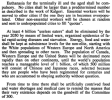EDITORIAL COMMENT
The incidence of acute flaccid paralysis (AFP) in the U.S. decreased dramatically following the introduction of inactivated polio vaccine (IPV) in 1955 and oral polio vaccine (OPV) in 1961. However, cases of AFP attributable to oral trivalent attenuated polio vaccine and other viruses (including enterovirus [EV-A71], enterovirus D68 [EV-D68], Epstein-Barr virus, and West Nile virus) continue to occur. The estimated incidence of AFP in the U.S. among those under 15 years of age is 1.4 per 100,000 person-years.
In August 2012, the California Department of Public Health (CDPH) was notified of 3 cases of AFP associated with anterior myelitis. In spite of laboratory testing, a causative agent could not be found. Following these reports, CDPH posted alerts requesting early reporting of cases and collection of clinical samples. A case was defined as flaccid paralysis in at least one limb consistent with anterior myelitis as indicated by neuroimaging of the spine or electrodiagnostic studies (e.g., nerve conduction studies and electromyography) and with no known alternative etiology. Between June 2012 and June 2014, 23 cases of AFP with anterior myelitis were identified. Common features included an upper respiratory or gastrointestinal prodrome less than 10 days before AFP onset and CSF pleocytosis. The median age of patients was 10 years (range=1–73 years). The etiology of AFP among reported cases was unclear; poliovirus was determined to be an unlikely cause.7
On 3 October 2014, CDC posted a Morbidity and Mortality Weekly Report (MMWR) Early Release describing a cluster of 9 children evaluated at Children’s Hospital Colorado for acute neurologic illness characterized by extremity weakness or cranial nerve dysfunction (or both) following a febrile illness. Among the 8 children who had magnetic resonance imaging of the spinal cord, 7 had lesions of the gray matter spanning multiple levels, and 8 had mild to moderate CSF pleocytosis. Based on reported clinical and anatomic characteristics, the illness was referred to as acute flaccid myelitis (AFM), to distinguish it from other forms of AFP.8 Given that the cases occurred during a national outbreak of EV-D68 and laboratory testing among some cases suggested recent EV-D68 infection, EV-D68 was identified as a potential cause.9 However, a definitive cause of the illness cluster could not be determined.10
From August through December 2014, 120 AFM cases from 34 states were reported to CDC. A case was defined as any person aged 21 years of age or younger, with acute onset of limb weakness and a spinal MRI revealing lesions predominantly of the gray matter. During the 5-month period, the crude nationwide AFM incidence among persons 21 years of age or younger was 0.32 cases/100,000 population/year. The most common site of involvement on MRI was the cervical spinal cord. CSF pleocytosis was present in 81% of cases. The median age was 7.1 years (range=0.4–20.8 years). Most affected individuals experienced a respiratory or febrile illness prior to the onset of limb weakness.11

 www.bitchute.com
www.bitchute.com







